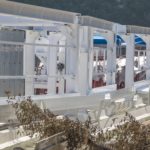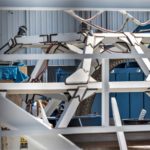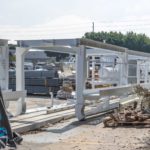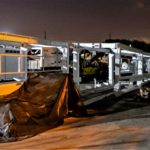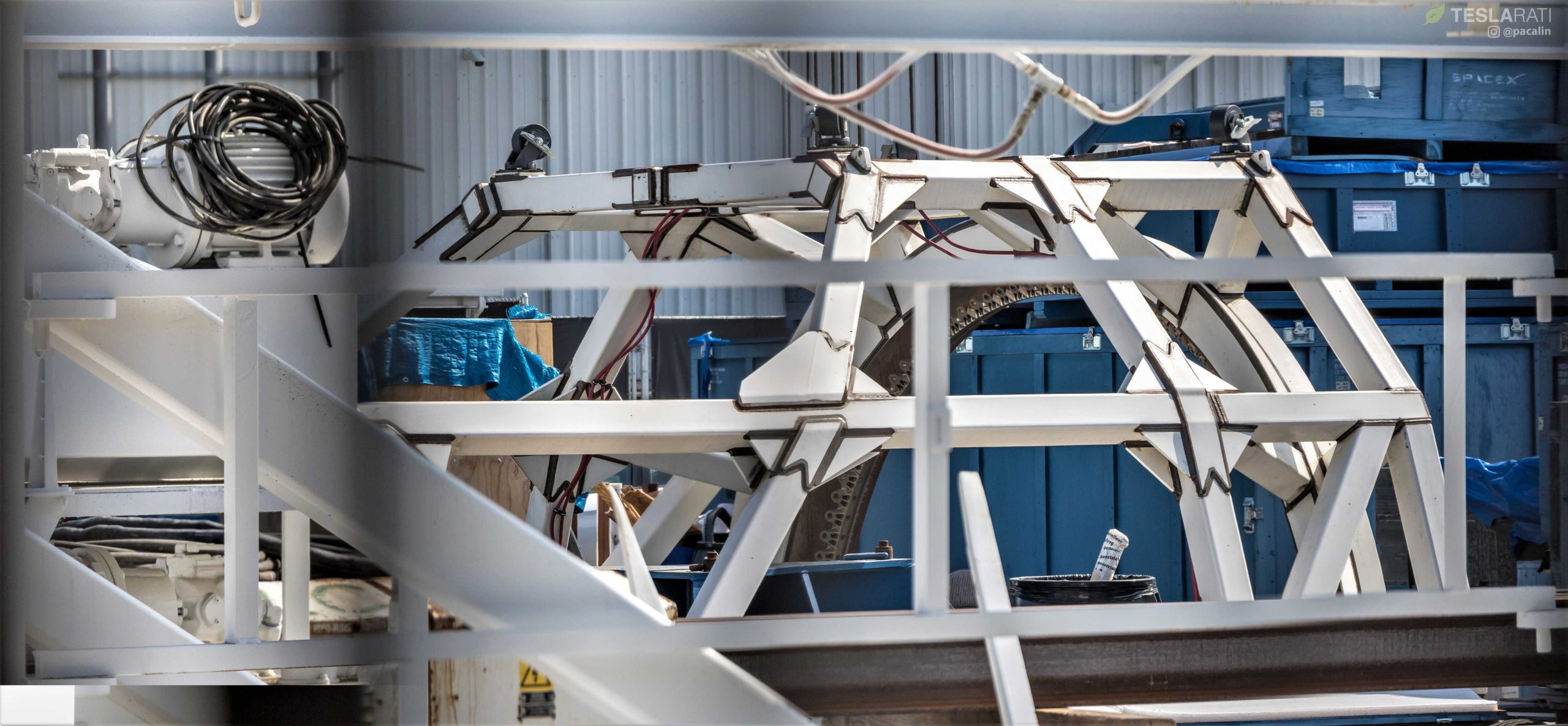
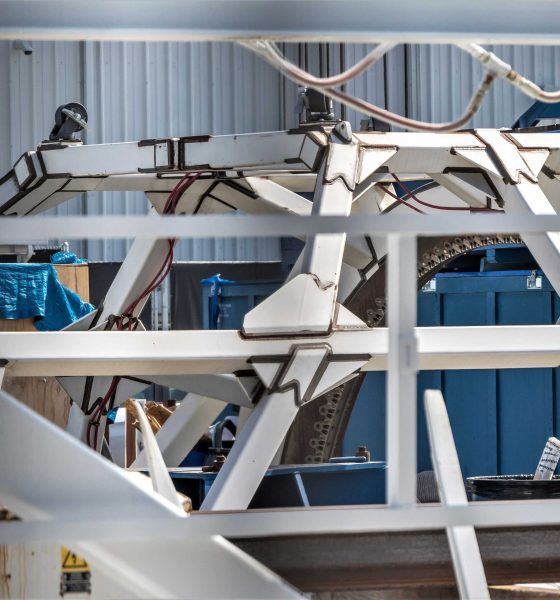
News
The Boring Company’s gantry and next-gen TBM takes shape ahead of Chicago project
While The Boring Company is hard at work preparing for the upcoming public showing of its proof-of-concept tunnel in Hawthorne, CA on December 10, the tunneling startup also appears to be laying the foundations for its high-profile transport project in Chicago. The project, which would connect downtown Chicago to O’Hare airport, is expected to break ground within the next few months.
The contract for the Chicago-O’Hare transport line had several key bidders, including veteran conglomerates with decades of experience in building transportation systems. Quite surprisingly, Chicago awarded the contract for the project to the young tunneling startup, partly due to The Boring Company’s commitment to funding the tunnel system through private investors. In true Elon Musk fashion, the timeline for the Chicago tunnels is aggressive, with the startup aiming to have the high-speed systems operational in 18-24 months after the initial digging.
The Boring Company has issued few updates on the Chicago project since it won the contract last June. Save for an image of a tunnel boring machine gantry that was shared on Twitter; the tunneling startup has been quite silent about the progress of its preparations for the high-profile project. Earlier this month, though, Teslarati photographers Pauline Acalin and Tom Cross were able to snap more images of the TBM gantry being built for the Chicago transport line. What’s more, sophisticated equipment in the same site also suggests that a large machine — possibly The Boring Company’s new TBM — is under construction.
- The Boring Company’s site for the assembly of its TBM gantry and its next-generation boring machine. [Credit: Pauline Acalin/Teslarati]
- The Boring Company’s site for the assembly of its TBM gantry and its next-generation boring machine. [Credit: Pauline Acalin/Teslarati]
The Boring Company’s construction site for its gantry and TBM. [Credit: Pauline Acalin/Teslarati]
During the Boring Company’s information session earlier this year, Elon Musk described the design of the startup’s tunnel boring machines. According to Musk, Godot, the company’s first TBM, is a conventional tunneling machine. Line-Storm, which was announced by Musk on Twitter last October, would be a hybrid, with parts from conventional boring machines and custom hardware designed by the company. Thanks to its hybrid nature, Line-Storm would be 2x faster than Godot. Proof-Rock, a third-generation TBM, will be developed entirely by the Boring Company, and it would be 10-15x faster than conventional TBMs.
It remains to be seen if the machine seemingly being assembled at the Hawthorne site is Line-Storm or Proof-Rock. That said, the Boring Company’s TBM for Chicago would most likely feature the startup’s most advanced tunneling tech yet. During the information session, Musk stated that the company’s boring machines, thanks to their electric nature (or partially-partially electric in the case of Line-Storm), the Boring Co’s machines are around 3x more powerful than conventional TBMs. The TBMs will be powered by Tesla batteries as well, eliminating the need for cabling in the actual tunneling site.
- A TBM gantry under construction. [Credit: Pauline Acalin/Teslarati]
- The Boring Company’s construction site for its gantry and TBM. [Credit: Tom Cross/Teslarati]
- The Boring Company’s next-gen tunnel-boring machine seen in its early stages, October 5th. [Credit: Tom Cross/Teslarati]
The Boring Company’s construction site for its gantry and TBM. [Credit: Pauline Acalin and Tom Cross/Teslarati]
The Chicago-O’Hare line is the Boring Company’s most ambitious project to date, estimated to be more than 17 miles long and costing around $1 billion when it’s complete. The transport line would feature the Loop System, which utilizes electric pods designed to transport up to 16 commuters at a time. The pods, which would be constructed by Tesla Inc., are all-electric, and are capable of traveling up to 150 mph. Seemingly as a means to make the manufacturing of the Urban Loop pods quicker and more efficient, Tesla would be using the Model X chassis as a basis for the vehicles.
Apart from the work being done on the Chicago TBM gantry, as well as the apparent assembly of its next tunnel boring machine, The Boring Company is also hard at work in completing its Hawthorne tunnel, which is set for public showing this coming December 10. A prototype garage-elevator concept that connects directly to the Hawthorne test tunnels is also being built on a private lot at 120th Street and Prairie Avenue, roughly halfway in the company’s 2-mile Hawthorne test tunnel.

Elon Musk
Elon Musk’s X will start using a Tesla-like software update strategy
The initiative seems designed to accelerate updates to the social media platform, while maintaining maximum transparency.

Elon Musk’s social media platform X will adopt a Tesla-esque approach to software updates for its algorithm.
The initiative seems designed to accelerate updates to the social media platform, while maintaining maximum transparency.
X’s updates to its updates
As per Musk in a post on X, the social media company will be making a new algorithm to determine what organic and advertising posts are recommended to users. These updates would then be repeated every four weeks.
“We will make the new 𝕏 algorithm, including all code used to determine what organic and advertising posts are recommended to users, open source in 7 days. This will be repeated every 4 weeks, with comprehensive developer notes, to help you understand what changed,” Musk wrote in his post.
The initiative somewhat mirrors Tesla’s over-the-air update model, where vehicle software is regularly refined and pushed to users with detailed release notes. This should allow users to better understand the details of X’s every update and foster a healthy feedback loop for the social media platform.
xAI and X
X, formerly Twitter, has been acquired by Elon Musk’s artificial intelligence startup, xAI last year. Since then, xAI has seen a rapid rise in valuation. Following the company’s the company’s upsized $20 billion Series E funding round, estimates now suggest that xAI is worth tens about $230 to $235 billion. That’s several times larger than Tesla when Elon Musk received his controversial 2018 CEO Performance Award.
As per xAI, the Series E funding round attracted a diverse group of investors, including Valor Equity Partners, Stepstone Group, Fidelity Management & Research Company, Qatar Investment Authority, MGX, and Baron Capital Group, among others. Strategic partners NVIDIA and Cisco Investments also continued support for building the world’s largest GPU clusters.
News
Tesla FSD Supervised wins MotorTrend’s Best Driver Assistance Award
The decision marks a notable reversal for the publication from prior years, with judges citing major real-world improvements that pushed Tesla’s latest FSD software ahead of every competing ADAS system.

Tesla’s Full Self-Driving (Supervised) system has been named the best driver-assistance technology on the market, earning top honors at the 2026 MotorTrend Best Tech Awards.
The decision marks a notable reversal for the publication from prior years, with judges citing major real-world improvements that pushed Tesla’s latest FSD software ahead of every competing ADAS system. And it wasn’t even close.
MotorTrend reverses course
MotorTrend awarded Tesla FSD (Supervised) its 2026 Best Tech Driver Assistance title after extensive testing of the latest v14 software. The publication acknowledged that it had previously criticized earlier versions of FSD for erratic behavior and near-miss incidents, ultimately favoring rivals such as GM’s Super Cruise in earlier evaluations.
According to MotorTrend, the newest iteration of FSD resolved many of those shortcomings. Testers said v14 showed far smoother behavior in complex urban scenarios, including unprotected left turns, traffic circles, emergency vehicles, and dense city streets. While the system still requires constant driver supervision, judges concluded that no other advanced driver-assistance system currently matches its breadth of capability.
Unlike rival systems that rely on combinations of cameras, radar, lidar, and mapped highways, Tesla’s FSD operates using a camera-only approach and is capable of driving on city streets, rural roads, and freeways. MotorTrend stated that pure utility, the ability to handle nearly all road types, ultimately separated FSD from competitors like Ford BlueCruise, GM Super Cruise, and BMW’s Highway Assistant.
High cost and high capability
MotorTrend also addressed FSD’s pricing, which remains significantly higher than rival systems. Tesla currently charges $8,000 for a one-time purchase or $99 per month for a subscription, compared with far lower upfront and subscription costs from other automakers. The publication noted that the premium is justified given FSD’s unmatched scope and continuous software evolution.
Safety remained a central focus of the evaluation. While testers reported collision-free operation over thousands of miles, they noted ongoing concerns around FSD’s configurable driving modes, including options that allow aggressive driving and speeds beyond posted limits. MotorTrend emphasized that, like all Level 2 systems, FSD still depends on a fully attentive human driver at all times.
Despite those caveats, the publication concluded that Tesla’s rapid software progress fundamentally reshaped the competitive landscape. For drivers seeking the most capable hands-on driver-assistance system available today, MotorTrend concluded Tesla FSD (Supervised) now stands alone at the top.
News
Elon Musk’s Grokipedia surges to 5.6M articles, almost 79% of English Wikipedia
The explosive growth marks a major milestone for the AI-powered online encyclopedia, which was launched by Elon Musk’s xAI just months ago.

Elon Musk’s Grokipedia has grown to an impressive 5,615,201 articles as of today, closing in on 79% of the English Wikipedia’s current total of 7,119,376 articles.
The explosive growth marks a major milestone for the AI-powered online encyclopedia, which was launched by Elon Musk’s xAI just months ago. Needless to say, it would only be a matter of time before Grokipedia exceeds English Wikipedia in sheer volume.
Grokipedia’s rapid growth
xAI’s vision for Grokipedia emphasizes neutrality, while Grok’s reasoning capabilities allow for fast drafting and fact-checking. When Elon Musk announced the initiative in late September 2025, he noted that Grokipedia would be an improvement to Wikipedia because it would be designed to avoid bias.
At the time, Musk noted that Grokipedia “is a necessary step towards the xAI goal of understanding the Universe.”
Grokipedia was launched in late October, and while xAI was careful to list it only as Version 0.1 at the time, the online encyclopedia immediately earned praise. Wikipedia co-founder Larry Sanger highlighted the project’s innovative approach, noting how it leverages AI to fill knowledge gaps and enable rapid updates. Netizens also observed how Grokipedia tends to present articles in a more objective manner compared to Wikipedia, which is edited by humans.
Elon Musk’s ambitious plans
With 5,615,201 total articles, Grokipedia has now grown to almost 79% of English Wikipedia’s article base. This is incredibly quick, though Grokipedia remains text-only for now. xAI, for its part, has now updated the online encyclopedia’s iteration to v0.2.
Elon Musk has shared bold ideas for Grokipedia, including sending a record of the entire knowledge base to space as part of xAI’s mission to preserve and expand human understanding. At some point, Musk stated that Grokipedia will be renamed to Encyclopedia Galactica, and it will be sent to the cosmos.
“When Grokipedia is good enough (long way to go), we will change the name to Encyclopedia Galactica. It will be an open source distillation of all knowledge, including audio, images and video. Join xAI to help build the sci-fi version of the Library of Alexandria!” Musk wrote, adding in a later post that “Copies will be etched in stone and sent to the Moon, Mars and beyond. This time, it will not be lost.”
